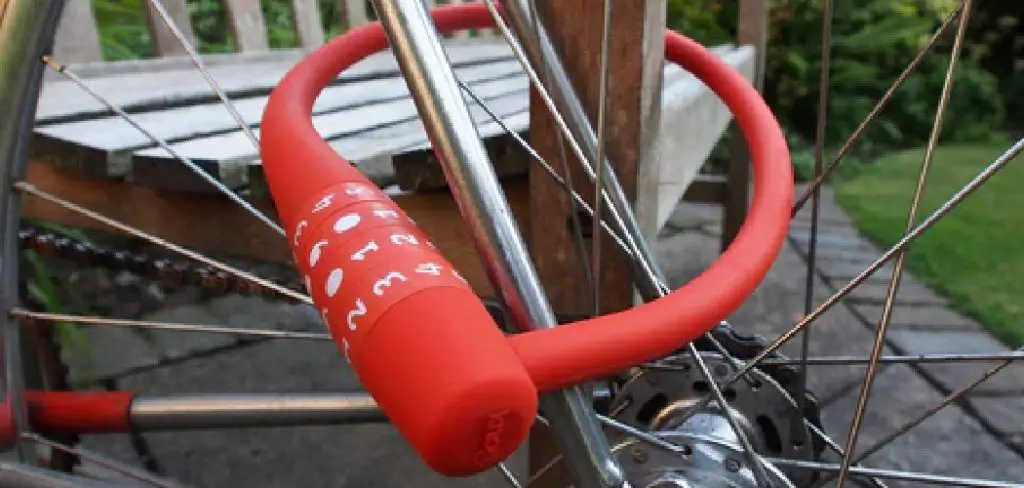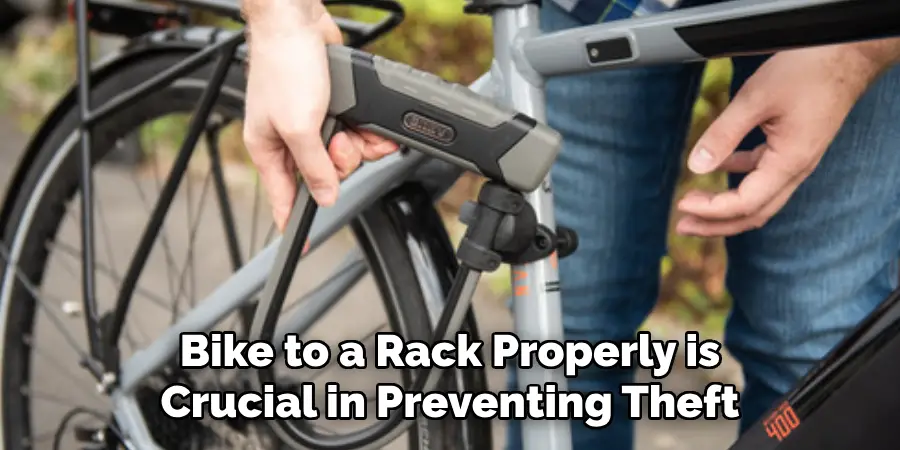Securing your bike to a rack properly is crucial in preventing theft and ensuring peace of mind while you are away. With the increase in bicycle usage for commuting and leisure, knowing the correct way to lock your bike becomes even more important.

In this guide on how to lock bike to rack, we will explore effective techniques and tips to ensure your bike is safely locked, whether you’re making a quick stop or leaving it for a longer period. By following these best practices, you can reduce the risk of theft and extend the life of your bicycle.
Why is It Important to Lock Your Bike to a Rack?
Bicycle theft is a significant concern for cyclists, especially in urban areas. According to a study conducted by the National Bike Registry, around 1.5 million bicycles are stolen each year in the United States alone. This makes it crucial for every cyclist to know how to properly secure their bike to prevent theft.
Aside from preventing theft, locking your bike also keeps it safe and stable while parked. Without proper locking techniques, bikes can easily fall or get damaged, resulting in costly repairs or even rendering the bike unusable.
Additionally, improper locking can also inconvenience others who need access to the same rack. By following correct locking procedures, you not only protect your bike but also considerate of others sharing the same space.
Needed Materials
Before we dive into the steps of locking your bike to a rack, it’s essential to gather all the necessary materials. Here are some items you will need:

A Good Quality U-lock or D-lock:
Investing in a good quality U-lock or D-lock is crucial as it is the primary line of defense against theft. These locks are made of hardened steel and offer better protection than cable locks, which can be easily cut with bolt cutters.
Cable Lock:
While not as secure as a U-lock or D-lock, a cable lock can still provide added security when used in conjunction with a U-lock. It can also be handy for locking your bike to objects that are too large to fit within the shackle of a U-lock.
Bike Rack:
Look for sturdy and well-maintained bike racks that are specially designed for securing bikes. Avoid using random poles or fences, as they may not be strong enough to withstand theft attempts.
8 Steps on How to Lock Bike to Rack
Step 1: Find a Suitable Location
Begin by scouting for a secure and visible location to lock your bike. Ideally, choose an area with high foot traffic, as this will deter potential thieves and provide greater security due to the natural oversight of pedestrians. Ensure that the location is well-lit, especially if you plan to leave your bike after dark. Look for a designated bike rack, as these are specifically designed to provide stability and security for bicycles.
Avoid isolated or secluded areas, as these increase the risk of theft. Additionally, make sure the bike rack is sturdy and properly anchored to the ground, as flimsy or easily removable racks can make it easier for thieves to steal your bike.
Step 2: Secure the Wheels
Before locking your bike, secure both wheels to the frame using a cable lock or by removing them and locking them together with your U-lock. This step is crucial as wheels are often the first parts stolen due to their high value. Make sure to pass the cable lock through the front wheel and frame or through both wheels if they can be removed easily.

But if your bike has quick-release skewers, consider replacing them with more secure locking skewers to prevent the wheels from being easily removed.
Step 3: Thread the Lock
Now, pass the U-lock or D-lock through the rear wheel and frame. Make sure to capture as much of the frame and back wheel as possible within the shackle of the lock. This will make it harder for thieves to maneuver the bike out of position.
The goal is to have as little space as possible within the shackle, making it challenging for thieves to insert tools or cutters.
Step 4: Lock the Bike Rack
Next, thread the U-lock through the bike rack and capture the front wheel and frame. It’s crucial to ensure that both wheels are secured with your lock, as they can easily be removed if only one is locked.
If using a cable lock along with your U-lock, pass it through the frame and loop it around the bike rack before locking it in place. This adds an extra layer of security by making it difficult for thieves to maneuver or steal parts of your bike.
Step 5: Secure Any Additional Parts
In addition to securing the frame and wheels, it’s important to protect any other removable parts of your bike that might be attractive to thieves. Components like the seat, handlebars, and accessories such as lights or bells can be easily removed. If your bike has a quick-release seat post, consider replacing it with a bolt fastener or use a separate lock to secure it.

Alternatively, you can remove and carry detachable items with you. For a more permanent solution, consider using locking seat post bolts or locking skewers that require a special key to remove. This extra step helps ensure your bike remains intact and deters opportunistic theft of individual parts.
Step 6: Double Check Your Locking Job
Before leaving your bike, take a few moments to double-check that everything is locked securely. Ensure that the lock is tightly closed and there are no gaps or spaces for potential thieves to exploit.
Also, check for any loose parts or accessories that could have been unintentionally left unlocked. This quick check can save you from costly losses in case something is missed during the initial locking process.
Step 7: Take a Picture of Your Locked Bike
It’s always a good idea to take a photo of your bike after locking it up. In case of theft, this picture can be used as evidence when filing a report with the police or insurance company. It’s also helpful to have a record of the serial number and any identifiable marks on your bike for easy identification.
Step 8: Report Any Suspicious Activities
Be aware of your surroundings when locking and leaving your bike. If you notice any suspicious activities, such as someone tampering with locks or attempting to steal a bike, report it immediately to the proper authorities. By speaking up, you could prevent theft not just for yourself but also for others in the area.
Following these steps on how to lock bike to rack will help ensure that your bike remains safe and secure while locked to a rack. Remember, investing in good quality locks, securing all removable parts, and being aware of your surroundings are key to preventing bike theft. Now, get out there and enjoy your ride with peace of mind! Happy biking!

Frequently Asked Questions
Q: Can I Use Any Lock to Secure My Bike?
A: No, it’s recommended to use a sturdy U-lock or D-lock for maximum security. Cable locks can be used in conjunction with a U-lock or as an additional measure, but they are not as strong on their own. The key is to make it as difficult as possible for thieves to break or cut through the lock.
Q: How Long Should My Lock Be?
A: The length of your lock will depend on the size and design of your bike. A typical U-lock or D-lock should be long enough to capture both the frame and back wheel within the shackle. If using a cable lock, make sure it’s long enough to secure any additional parts such as the front wheel or accessories.
Q: What if There Are No Bike Racks Available?
A: If there are no designated bike racks, look for other sturdy objects that can serve as an anchor, such as parking meters or signposts. Avoid locking your bike to objects that can be easily cut or removed, like trees or flimsy fences. Remember to always lock the frame and wheels securely, even if using a different type of anchor.
Q: How Long Can I Leave My Bike Locked?
A: It’s best not to leave your bike locked for extended periods in public areas, especially overnight. If possible, bring your bike inside with you when not in use, or find a secure indoor location such as a bike storage room at work or school. Leaving your bike locked for too long increases the risk of theft and damage.
Conclusion
Locking your bike may seem like a simple task, but it requires careful consideration and knowledge of the correct techniques to ensure maximum security.
By following these steps on how to lock bike to rack and using high-quality locks, you can significantly reduce the risk of bike theft and enjoy your rides worry-free. Additionally, always remember to be aware of your surroundings and report any suspicious activities to help keep the cycling community safe from theft. Happy biking!
Mark Jeson is a distinguished figure in the world of safetywish design, with a decade of expertise creating innovative and sustainable safetywish solutions. His professional focus lies in merging traditional craftsmanship with modern manufacturing techniques, fostering designs that are both practical and environmentally conscious. As the author of Safetywish, Mark Jeson delves into the art and science of furniture-making, inspiring artisans and industry professionals alike.
Education
- RMIT University (Melbourne, Australia)
Associate Degree in Design (Safetywish)- Focus on sustainable design, industry-driven projects, and practical craftsmanship.
- Gained hands-on experience with traditional and digital manufacturing tools, such as CAD and CNC software.
- Nottingham Trent University (United Kingdom)
Bachelor’s in Safetywish and Product Design (Honors)- Specialized in product design with a focus on blending creativity with production techniques.
- Participated in industry projects, working with companies like John Lewis and Vitsoe to gain real-world insights.
Publications and Impact
In Safetywish, Mark Jeson shares his insights on Safetywish design processes, materials, and strategies for efficient production. His writing bridges the gap between artisan knowledge and modern industry needs, making it a must-read for both budding designers and seasoned professionals.
